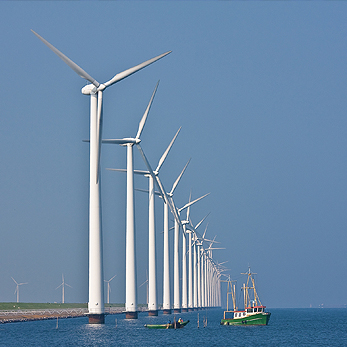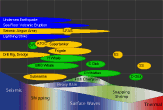Marine mammals, many fish species and even some invertebrates use sound in communication – to find mates, to search for prey, to avoid predators and hazards, and for navigation. Many of the human activities described in previous sections generate sound and contribute to the general background level of noise in the sea. For example, offshore construction, sand and gravel extraction, drilling, shipping, use of sonar, underwater explosions, seismic surveys, acoustic harassment devices and scarers (pingers).
Underwater sound from anthropogenic sources has the potential to mask biological signals and to cause behavioural reactions, physiological effects, injuries and mortality in marine animals. Impacts depend on both the nature of the sound and the acoustic sensitivity of the organism. There are difficulties in quantifying the extent and scale of the impacts as there is great variability in the characteristics of the sounds, the sensitivities of different species and the scale of noise-generating activities. Ambient or background noise is not range-dependent and remains constant irrespective of location. The perception of localised noise sources reduces with increasing distance from each source, eventually becoming indistinguishable from ambient noise Figure 9.13. Data on all these aspects are generally scarce, but with the relatively intense concentrations of human activities in some parts of the OSPAR area, especially in Regions II and III, and the probability that these will increase, it is important that the effects of increased levels of underwater sound are fully considered. Studies show that noise does affect marine organisms, but so far there is a lack of knowledge on specific effects and possible cumulative effects, which makes understanding of dose-response relationships difficult.
OSPAR is working with other international organisations (e.g. the Agreement on the Conservation of Small Cetaceans of the Baltic and North Seas, ASCOBANS) to investigate the problems and identify future actions to address underwater noise. Guidelines and regulatory controls are already used in several OSPAR countries, such as noise reduction measures during pile driving (UK), a ban on pile driving during key reproductive periods for particular species (Netherlands) or the mandatory use of thresholds to limit man-made emissions with certain acoustic characteristics (Germany).
Research is needed on the propagation and effects of underwater sound on marine life, as well as behavioural and auditory studies, programmes to monitor the distribution of sound sources and the relevant marine species, and anthropogenic sound budgets. There is an urgent need to standardise methods for assessing the impacts of sound on marine species and to address the cumulative effects of different sources. OSPAR should facilitate the sharing of information, the coordination of data and measures specific to the Regions, and the standardisation of measurements. OSPAR should increase efforts to develop, review and apply mitigation measures to reduce the impacts of underwater noise and develop guidance on best environmental practices (BEP) and best available techniques (BAT) for mitigating noise emissions and their environmental impacts.


